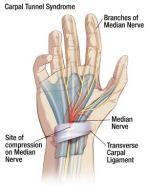- Home
- Prevention program
- Carpal Tunnel Prevention
Carpal tunnel prevention advice from the experts
ScienceDaily (Mar. 12, 2007) — A group of human factors/ergonomics researchers have conducted the first study that systematically identifies how one contributor to carpal tunnel syndrome -- carpal tunnel pressure -- can be examined in detail to establish limits on how much a wrist can be flexed before nerve damage sets in.
In work involving the hands, whether using a computer or a hammer, the wrist is a vulnerable spot. Repeated or sustained bending and flexing can lead to carpal tunnel syndrome (CTS).
A group of human factors/ergonomics (HF/E) researchers from the University of California at San Francisco and McMaster University in Ontario, Canada, have conducted the first study that systematically identifies how one contributor to CTS -- carpal tunnel pressure -- can be examined in detail to establish limits on how much a wrist can be flexed before nerve damage sets in.
The researchers believe their findings could be used to create simple guidelines to help workers avoid wrist postures that are likely to cause nerve trauma. The findings from their study appear in a paper in the February issue of Human Factors: The Journal of the Human Factors and Ergonomics Society.
The research team studied the pressure that is placed on the nerve in the carpal tunnel in various wrist postures in 37 healthy men and women between the ages of 22 and 50. Wrist postures that are not neutral (that is, bent or flexed) cause increased pressure on the nerve. The researchers concluded that when sustained pressure on the carpal tunnel reaches 30 mmHG, injury is likely to occur.
In order to keep pressure below 30 mmHG, it is recommended that sustained wrist extension (bending the hand back) should not exceed 32.7 degrees, wrist flexion (bending the wrist toward the palm) should not exceed 48.6 degrees, ulnar deviation (sideways toward the small finger) should not exceed 14.5 degrees, and radial deviation (sideways toward the thumb) should not exceed 21.8 degrees.
The researchers believe that a set of guidelines could be developed from their data -- guidelines that could, if applied by engineers and designers during the design of work and tools, protect workers. Such guidelines could also be used to identify tasks that may put workers at risk for developing or aggravating CTS.
Adapted from materials provided by Human Factors and Ergonomics Society.
For more Carpal tunnel prevention advice
Best Carpal tunnel braces
Best Night splints
Best Pain Relieving creams/gels
Hand exercises
- Home
- Prevention program
- Carpal Tunnel Prevention
Share this page:
Recent Articles
-
The carpal tunnel store
The carpal tunnel store has a huge selection of Medical Grade Products -
Anatomy of the carpal tunnel
The carpal tunnel anatomy is easy to understand if you remember we're dealing with a tunnel of sorts in your wrist. Learn the anatomy from a medical practitioner. -
Carpal tunnel prevention program
A carpal tunnel prevention program at the workplace may help employees from getting symptoms. Learn the best carpal tunnel prevention program on the web today.
Recent Articles
-
The carpal tunnel store
The carpal tunnel store has a huge selection of Medical Grade Products -
Anatomy of the carpal tunnel
The carpal tunnel anatomy is easy to understand if you remember we're dealing with a tunnel of sorts in your wrist. Learn the anatomy from a medical practitioner. -
Carpal tunnel prevention program
A carpal tunnel prevention program at the workplace may help employees from getting symptoms. Learn the best carpal tunnel prevention program on the web today.
